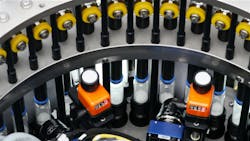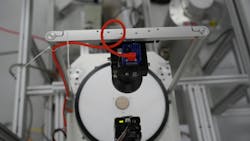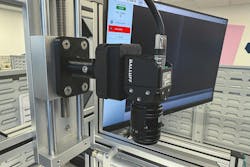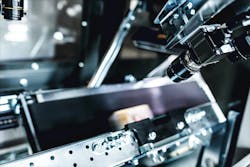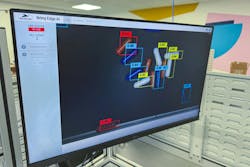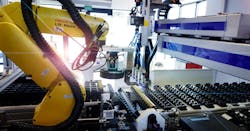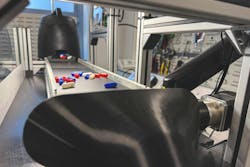An engineer's guide to smart, industrial and embedded vision
Key highlights
- There are distinct capabilities of smart cameras for standalone inspections, of industrial cameras for scalable multi-camera systems and of embedded vision for integrated, edge-processing applications within machinery.
- Understanding interface options like GigE for industrial cameras and PCIe/MIPI for embedded systems is crucial for designing robust and high-performance vision integration into custom machinery.
- The trends in edge AI for smart cameras and the increasing performance and simplified integration of embedded vision systems will directly impact the design and capabilities of future industrial automation equipment.

Pushing Boundaries: Industrial Cameras vs. Smart Cameras
FRANK JAKUBEC
BALLUFF
Vision systems are essential in industrial automation, driving improvements in efficiency, quality and precision. Three key categories—smart cameras, industrial cameras, and embedded vision systems—each offer distinct advantages tailored to specific applications. These technologies continue to evolve with new interfaces, sensors and processing capabilities.
Smart cameras: versatile solutions for targeted applications
Smart cameras are self-contained units that combine a camera, processor and image-processing software into a single device, making them ideal for applications where simplicity and flexibility are paramount. They are available in two main types: open and closed systems.
Open smart cameras: Typically based on Linux, they allow extensive customization but require programming skills and experience in image processing. A wide range of software is available for these systems—OpenCV, MatLab and TensorFlow libraries are considered standard among vision specialists. Open smart cameras are ideal for companies and applications that need tailored algorithms. The Linux platform is highly flexible, enabling the implementation of custom smart software and offering greater freedom during development.
These cameras are especially well-suited for serial applications used in dozens or even hundreds of installations. In such scenarios, cameras must make autonomous decisions, without the need to be connected to larger decision-making systems, and the available time for evaluation is minimal.
Closed smart cameras: This category includes basic identification sensors, such as barcode readers, and vision sensors. However, the standard is more advanced cameras with a wide range of built-in features. Users typically expect functions like verification, presence checks, edge analysis, error detection and blob analysis. The latest models also offer advanced features such as inclination monitoring, installation assistance, humidity and temperature sensing and vibration monitoring.
These cameras are widely used in automated production lines, with their main advantage being ease of use. The best models come with highly intuitive software that supports a broad range of applications.
The main drawback is limited flexibility. Users are often restricted to the built-in software. If more customization is needed, users must switch to open smart cameras, which require more advanced knowledge than what a typical line technician possesses.
Still, closed smart cameras are excellent for specific inspection tasks, such as quality control or defect detection in manufacturing (Figure 1).
Future trends for smart cameras: Advancements in edge artificial intelligence (AI) will enable smart cameras—both open and closed—with more complex image processing directly on the device and reduce the need for cloud computing (Figure 2). Traditional machine-vision algorithms are becoming increasingly dependable, thanks in part to new, high-performance image sensors developed specifically for smart cameras. These improvements will continue to enhance performance and expand potential applications.
While AI is a major trend, it is important to keep expectations realistic. Integrated processing boards still have limitations, and smart cameras are best suited for detecting one type of defect at a time. For more complex or varied inspections, industrial cameras with powerful external computers remain the better choice (Figure 3).
At the same time, the overall complexity and capability of smart cameras are steadily increasing. Their growing functionality, along with the wide availability of accessories, such as advanced lighting systems and a variety of lenses, is expanding their usefulness and application range. The demand for smart cameras in industrial automation is not slowing down, and their role on production lines will only continue to grow (Figure 4).
Industrial cameras: scalable vision for complex systems
Industrial cameras are designed for diverse, high-volume image-processing tasks, relying on a connected PC for processing power. This architecture makes them highly scalable and cost-effective for systems requiring multiple cameras, such as large-scale production lines.
These cameras are ideal for applications requiring high resolution and flexibility. Connecting multiple cameras to one PC reduces hardware costs. Image-processing software is usually provided by third-party vendors. It can be either paid, such as Halcon, LabView and NeuroCheck, or open source, such as OpenCV. However, such systems demand expert knowledge and are not ideal for single-purpose machines with limited repeatability.
Industrial cameras support a wide range of sensors, from rolling shutters for static imaging to global shutters for fast-moving objects. They also offer advanced imaging options beyond the visible spectrum, such as ultraviolet (UV), short wavelength infrared (SWIR), polarized light and event-based sensors that detect real-time changes.
The true strength lies in their flexibility. Synchronization between multiple cameras ensures that the connected PC is optimized for the specific timing requirements of each unit. Industrial systems can deliver extensive savings in large-scale deployments; however, they come with higher demands for setup, maintenance and operator skill.
Future trends for industrial cameras: Industrial cameras support various interfaces, including USB and GigE. USB is popular for ease of use and speed, while GigE has enabled massive scalability. Newer standards like 5GigE and 10GigE offer higher speeds and power efficiency, with features like power over Ethernet (PoE) and backward compatibility. Soon, we can expect to see 25GigE, 50GigE and even 100GigE interfaces for real-time transmission of high-resolution data enabling near-instant data transfer using remote direct memory access over converged Ethernet, version 2 (RoCEv2/RDMA).
However, the more advanced the sensor, the higher the camera cost. Additionally, complementary components like compatible optics and lighting are critical—without them, even high-end cameras will not perform to their full potential.
Get your subscription to Control Design’s daily newsletter.
Embedded vision: compact power at the edge
Embedded vision systems combine the autonomy of smart cameras with the flexibility of industrial cameras. They rely on compact computing units—usually advanced RISC (reduced instruction set computing) machine (ARM)-based boards—ranging from entry-level devices like Raspberry Pi to mid-range options like NXP or NVidia Xavier and high-end platforms like NVidia Orin. These systems are designed for edge computing, where image data is processed locally, and only essential results are sent to the cloud or a central system.
You could consider them a type of smart camera, and you would be partly right. However, embedded vision systems are most often fully integrated into larger machines or devices. Common examples include microscopes, optical scanners and traffic cameras used for speed enforcement or number plate recognition.
These are typically single-purpose vision systems, developed for specific tasks. Rather than designing their own cameras, companies select the best embedded PC to run highly specialized software, often developed in-house. Because of this uniqueness, off-the-shelf smart camera software is rarely used.
Speed, efficiency and low latency are top priorities. Companies with these systems typically choose one of two primary camera interfaces:
- mobile industry processor interface (MIPI): A cost-effective solution for lower-resolution applications
- peripheral component interconnect express (PCIe): a scalable, high-performance option with minimal latency, ideal for high-resolution and high-speed imaging.
And for users who prefer traditional interfaces, most ARM-based PCs can also connect to USB or Ethernet cameras without issues.
Future trends for embedded cameras: AI is already a standard in this space, so the focus is shifting elsewhere. The key trend is the continued rise of PCIe, thanks to its excellent scalability and performance. It is the go-to interface for high-speed, high-resolution vision systems.
On the other hand, MIPI remains a strong choice for budget-sensitive projects or lower-resolution needs.
But perhaps the most exciting trend is the simplification of image sensor interfaces, which are making it easier than ever to connect and integrate cameras with embedded systems, thereby reducing development complexity and speeding up time to deployment.
Choosing the right system for your needs
Selecting the best vision system depends on your specific operational needs.
Smart cameras are ideal for self-contained tasks where simplicity and integration ease are key. They are perfect for repeatable inspection processes with moderate throughput (Figure 5).
Industrial cameras shine in environments that demand multiple synchronized units, high resolution and adaptability. They are the best fit for large-scale, complex production lines.
Embedded vision systems are suited for compact, edge-driven applications where processing power needs to be close to the source. These are favored in Internet of Things (IoT) systems and custom machine designs with MIPI or PCIe camera integration.
Conclusion
Smart cameras, industrial cameras and embedded vision systems each play a critical role in the evolution of industrial automation. Whether you prioritize simplicity, scalability or edge computing performance, choosing the right type ensures better efficiency, higher quality and optimized results. The synergy between advanced sensors, high-speed data interfaces and edge AI will drive the next wave of innovation in machine vision, enabling smarter, faster and more adaptive automation across industries (Figure 6).
Next steps
- Based on current or upcoming machinery projects, identify specific applications where smart, industrial or embedded vision systems could offer significant improvements in efficiency or quality.
- Research specific vendors and products within one of the discussed vision-system categories that align with the identified application requirements and the team's technical expertise.
- To gain practical experience, explore setting up a small-scale proof-of-concept project using a low-cost option like a closed smart camera or an embedded vision platform like Raspberry Pi with a compatible camera.
About the Author
Frank Jakubec
Balluff
Frank Jakubec, head of global market segment sales for Semicon & Electronics, Balluff, will present "Pushing Boundaries: Industrial Cameras vs. Smart Cameras" at 10:15 am on May 15 during A3's Automate 2025 in Detroit.
Jakubec is a seasoned automation and technology specialist. With more than 14 years of experience in business-to-business product and solution sales, Jakubec is an expert in machine vision and has a talent for business development. His background combines engineering and business. He earned both his bachelor’s in electronics and communication technologies and master’s in business and commercial engineering at industry from Czech Technical University, the mix helping bridge technical challenges with customer needs to shape strategies that work in real-world manufacturing environments. He can be contacted at [email protected].

Leaders relevant to this article:
